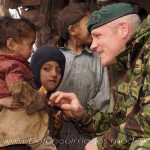War’s changed landscape – how modern war has changed. Available here from Howgate Publishing
For Defence and Security practitioners, engaging in academic debate about their profession can be challenging. It is not just that finding the time can be difficult, nor that so much of what has been espoused about the profession of arms bears so little resemblance to the kit and equipment that individuals operate or how they operate it. It is that the language of Defence has become impenetrable, and that ‘new’ and ‘innovative’ ideas and thoughts have become so faddish that it is easy to become disorientated in the tangle of concepts, doctrine, lessons, and ‘insights’.
Whilst the authors describe this book as a primer – and it does an excellent job of introducing and explaining some of the faddish ideas floating around Defence and Security thinkers today – the book is more than this. It attempts to explain how these ideas and thoughts interact and how change manifests itself, and, critically, how we have ended up where we are, placing these ideas within the context of modern warfare. The book conceptualises the Norms of warfare – ‘patterns of behaviour which makeup rules and often ambiguous responses that drive actors’ actions and responses’, and Forms of warfare – ‘that concern the measures and means undertaken by both state and non-state actors in the activity of prosecuting war’. It uses a variety of sources, including interviews with a variety of high-level practitioners. The authors explain how the forms and norms of warfare interact both with contemporary dialogue (the faddish tangle mentioned earlier) and the context and realities of what we have recently seen, with a focus, but not exclusively so, on Ukraine.
The authors are both well-known thinkers within the profession of arms. Walker, a retired Army Officer, has a PhD focused on autonomous weapons and has extensive experience in human rights and collateral damage considerations. Roberts, a former Naval Officer, is well known for his time as the Director of Military Science at RUSI, where he hosted the hugely popular Western Way of War podcast. Both authors have practical military experience, and an understanding of how militaries routinely operate in practice. They are also both heavily involved in the think-tank and academic world that has generated some of the more outlandish claims that we have seen in the past decade, or, as they describe them, “voguish fads”.
Whilst this book utilises many sources from think tanks, universities and other quasi-academic sources, the authors also interviewed leaders and thinkers across Western Defence and Security organisations. Before the war in Ukraine, much of the evidence gathered in interviews ‘foresaw a fluid and largely non-conventional set of measures expected to comprise the new battlefield’. Then, as the authors say, Ukraine happened. It would have been too easy for the authors to use this as a classic example of how, once again, the brains of military and academic thinkers become confused, misdiagnosing and drawing incorrect conclusions. Instead, the authors make the admirable and beneficial attempt to pick apart the web of concepts, doctrine and lessons and explain how militaries think, approach problems, and ultimately learn – both correctly and incorrectly at times.
When reading this book, it is easy to come to the conclusion that there are so many variables involved in contemporary war fighting that, perhaps, no one will be able to draw solid themes to focus on, or separate fact from fiction. The authors conclude the book with a message – context is critical – and they do an excellent job of explaining and expanding on this point throughout. What might look like evidence (often military ‘thinking’ is lacking in both evidence and context) will potentially look highly different over time. Understanding the dynamic relationship of technology, change, human nature and warfighting is explained eloquently and clearly throughout. This book won’t give you answers, but it does an excellent job of explaining how this complexity manifests itself on the battlefields we see today.
It is easy to become exasperated at the sheer quantity of ‘informed’ and ‘insightful’ commentaries and academic works that comment on contemporary changes in war and warfare as if they are something uniquely new and novel. New books are sighted as ‘must reads’ or ‘game-changing works’ only to be spectacularly disproved months or even weeks later. It can be challenging to understand where to start, or even the interconnectedness of warfare that we know exists today.
This book is not just a primer into these themes and concepts; it is a primer into both contemporary warfare and how we think about modern warfare. Both need to be understood, to understand how we have reached this point in time. As the authors say, the conduct of warfare has changed very little if you take a pragmatic and clear-eyed view of proceedings. This a refreshingly honest assessment of how we have thought about war and how people have fought wars in recent history.
The Wavell Room Team
The Wavell Room Team are a bunch of enthusiastic individuals who believe strongly in constructive debate, discussion and openness in order to arrive at a sound, non-bias and informed position on many subjects. The team are all volunteers and support this non-profit in their own time.





